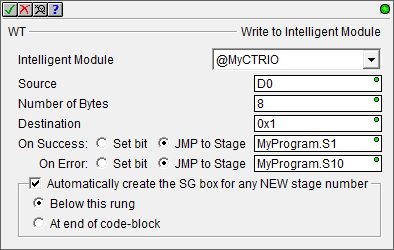Topic: DMD0076
WT - Write to Intelligent Module
The Write to Intelligent Module (WT) instruction is used to write a specified number of bytes of data from memory in the CPU to the specified location in an Intelligent Module's shared RAM. Traditionally this instruction was used to manage intelligent modules at runtime. Do-more CPUs provide a complete interface to the runtime configuration of these modules through the System Configuration or through other instructions. This instruction remains as part of instruction set in case there are instances in the future when this functionality is again required.

Parameters:
Note: Use the F9 key or click the 'three dot box' at the right edge of the parameter field to open the Default Element Selection Tool (the Element Picker or the Element Browser) or use the Down-Arrow key (Auto-Complete) on any parameter field to see a complete list of the memory locations that are valid for that parameter of the instruction.
Intelligent Module - selects which Intelligent I/O module to write to
No devices available - indicates that there are no Intelligent Modules in the system. Select the following to create the required module:
create module - select this option to open the Module Configuration dialog of the System Configuration to create a new module configuration.
Source - specifies the first location of the data that will be written to the module. This can be any readable numeric location.
Number of Bytes - specifies the number of bytes of data to write to the module. This can be any positive constant integer from 1 to 2147483648, or any readable numeric location.
Destination - specifies the beginning address in the module where the data will be written. This can be any positive constant integer from 0 to 2147483647, or any readable numeric location. For details on specific destination addresses for specific modules, reference the user manual for that specific module.
The On Success and On Error parameters specify what action to perform when this instruction completes. You do not have to use the same type of selection for both On Success and On Error.
If the Set Bit selection is used for either On Success or On Error, the specified BIT location will be SET OFF when the instruction is first enabled and will remain OFF until the instruction completes. Once complete, the appropriate Success or Error bit location ON. The specified Bit location is enabled with a SET (Latch) operation meaning that it will remain ON even if the input logic for the instruction goes OFF.
If the JMP to Stage selection is used for either On Success or On Error the target Stage must be in the same Program code-block as this instruction, you cannot specify a target Stage that exists in a different Program code-block. When the operation finishes, the target Stage will be enabled the same way as a standalone Jump to Stage (JMP) instruction would do it. The JMP to Stage option will only be available if this instruction is placed in a Program code-block.
On Success selects which of the following actions to perform if the operation is successful:
- Enable SET Bit then specify any writable bit location.
- Enable JMP to Stage then specify any
Stage number from S0 to S127 in the current Program code-block.
On Error selects which of
the following actions to perform if the operation is unsuccessful:
- Enable SET Bit then specify writable bit location.
- Enable JMP to Stage then specify any Stage number from S0 to S127 in the current Program code-block.
If either the On Success or On Error selections are set to JMP to Stage, Automatically create the SG box for any NEW stage number will be enabled which will automatically create any target stage that does not already exist.
- Below this rung will create the new target stage on a new rung following this instruction.
- At end of code-block will create the new target stage as the last rung of this Program.
Status Display:

The red triangle in the upper left corner indicates this is a Fully Asynchronous instruction.
See Also:
RD - Read from Intelligent Module
